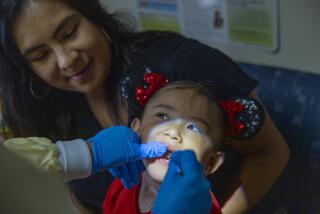Pharmacists’ Patient Profiles Prove Helpful
- Share via
If your pharmacist doesn’t keep patient profiles--drug histories with records of allergies and sensitivities--he or she is in the minority.
A 1987 poll by the journal Pharmacy Times reveals that 90.2% of retail pharmacies maintain such records, compared with 81% in 1986; and 91.8% of hospital pharmacies keep them, about the same number as a year ago, said a journal statistician.
The profiles, often computerized, are an especially good idea for the elderly, because they may see several different medical specialists, said Robert C. Johnson, a pharmacist and executive vice president of the California Pharmacists Assn., which urges members to keep such records. The profiles, which also include insurance and Medicare information, can reduce the chance of emergency hospitalization, Johnson added.
“About 7% to 10% of hospital admissions are related to adverse drug reactions,” Johnson said. “And those are the ones serious enough to put someone in the hospital.”
Consumers can help boost the effectiveness of the drug profiles, he added, by remembering to tell the pharmacist about over-the-counter drugs, such as aspirin, they may be taking.
But the profiles are not foolproof, as Johnson pointed out.
For one thing, allergies can develop at any time, and a patient profile would not reveal an unexpected reaction to a drug or drugs.
Evidence of this is the recent experience of Alexander Haig. When the Republican presidential candidate developed a toothache last week, he sought help at the Walter Reed Army Medical Center in Washington and was prescribed Tylenol and penicillin, according to James Stueve, a hospital spokesman. “Later on (Wednesday, after leaving town), he developed shortness of breath,” Stueve added.
The former secretary of state and chief of staff then checked himself into the Fairfax Hospital (where he stayed overnight) in nearby Falls Church, Va., said Mary Stuart Rizk, a hospital spokeswoman.
Doctors there also observed low blood pressure and skin rash and said he was having an allergic reaction to the drug combination, she said.
Haig had taken the combination before without a reaction, Rizk added.
Up-to-Date Dental Exams
In years past, the family dentist zeroed in on finding tooth decay during a patient’s routine checkups.
No longer. “With decay on the decline, dentists are focusing on other areas of oral health,” according to Anthony Kiser, a dentist who serves as secretary of the American Dental Assn. Council on Dental Practice.
Detection of periodontal (gum) disease is one focus, fueled partly, Kiser believes, by the recent increase in malpractice suits for failure to diagnose it.
Infection control is another concern.
“Dentists have taken infection control more seriously because of AIDS,” Kiser said, “but the most significant (infection) problem in the dental office is hepatitis.”
Ideally, today’s dental exam should include the following procedures and precautions, according to Kiser.
--A complete patient health history. “That health history should be updated at each subsequent visit,” Kiser said.
--A thorough soft-tissue exam of the face, head and neck, including the tongue, roof of the mouth and lips.
“Dentists are frequently the people who identify cancers in the head and neck regions,” Kiser said. And they can be the first to detect such conditions as temporomandibular joint dysfunction, a painful jaw malfunction often accompanied by clicking or grinding noises during the jaws’ opening and closing.
--Periodontal probing to detect gum disease, which accounts for the majority of adult tooth loss.
“Dentists should examine the gums and use a periodontal probe and examine the attachments of the teeth to the gums,” Kiser said.
--Infection control precautions.
“You should expect your dentist to be wearing gloves at a minimum,” Kiser said, “and when doing a procedure that includes splashing or splattering of saliva, the dentist should wear eye coverings and a face mask.”
Diet Strategies
It may be the most common New Year’s resolution. And the gloomiest, sooner or later, when the pounds either refuse to fall off or do a disappearing/reappearing act.
“Probably nine out of 10 dieters regain the weight they lose,” estimates Sharon Higgins, a Los Angeles registered dietitian and a California Dietetic Assn. spokeswoman.
Still, perseverance is the status quo. At any given time, 37% of the adult U.S. population--about one of every two women, one of every four men--is on a diet, according to 1986 estimates from the Calorie Control Council, an Atlanta-based organization representing manufacturers and suppliers of low-calorie foods and beverages.
How to improve the chances of joining the slim ranks of the stay-svelte set? Here are ideas from four registered dietitians:
--Concentrate not just on calorie reduction, but on rest and relaxation.
“If people don’t sleep well, they’ll be fatigued and won’t exercise,” said Lisa Beckley-Barrett, a Palm Desert registered dietitian. “And fatigue predisposes people to consume more sugar.”
--Be self-motivated. “You can’t be dieting for someone else,” said Higgins, who says she lost 25 pounds five years ago and has managed to keep them off.
--Forget your mental “good food/bad food” list. “People get all hung up on do’s and don’ts,” said Susan Magrann, an Anaheim registered dietitian and CDA spokewoman. “Instead of taking the approach that (certain) foods are bad and you can never have them, learn to rate them and decide if they’re worth the calories,” Magrann said.
Following a diet with no “forbidden foods” prevents what Evelyn Tribole, an Irvine registered dietician and CDA Spokesperson, calls the “pink elephant syndrome.’






